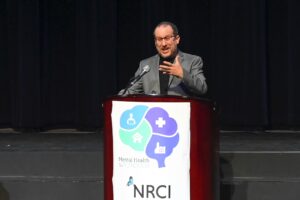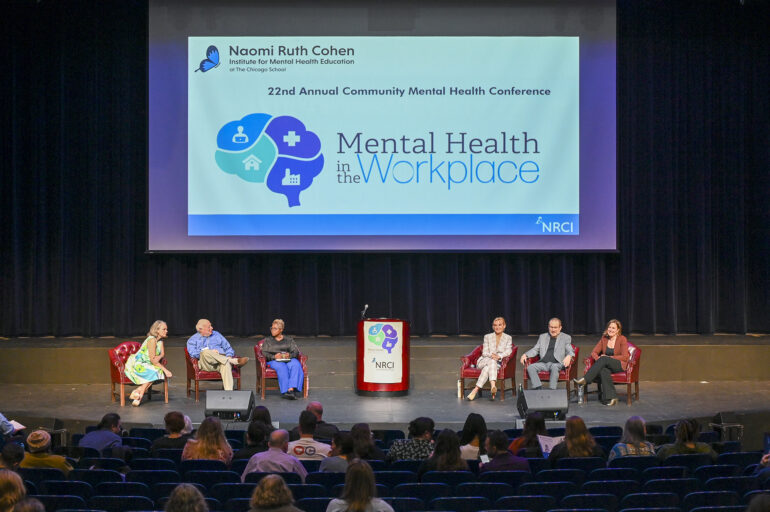The workplace has long been a source of stress. On top of the expectations for performance, potential conflicts with co-workers, the presence of discrimination, and demanding bosses, there is the ever-present awareness that one’s economic security depends on being employed. Traditionally, employers have not prioritized the mental health of their workers. Consequently, workers have long felt that stoically suppressing their feelings and carrying on was the sign of a team player.
On June 8, the 22nd annual conference of the Naomi Ruth Cohen Institute for Mental Health Education (NRCI) convened at Evanston Township High School in Evanston, Illinois. This year’s theme was Mental Health in the Workplace.
In his opening remarks, Larry Cohen, cofounder of NRCI, described the day his daughter Naomi came to him for advice about a job change. She was struggling due to her diagnosis of bipolar disorder and felt that she couldn’t continue in her role as advocate for senior citizens and planned to go into retail sales. She asked her father for advice on how to handle the transition with her future employer.
For Larry Cohen, who was a labor lawyer, this was an opportunity to support his daughter in his area of expertise. He counseled her to explain her condition and needs and how to work out accommodations. He explained to her that it would be against the law for them to retaliate against her. Naomi replied that she knew all that but was afraid that when she told her employer she was bipolar, she would be “damaged goods” and not be given the same opportunities as, while being resented by, her co-workers.
As Cohen experienced in Naomi’s case, laws protecting employees’ rights are only effective if they are paired with workplace policies that prioritize mental wellness among their workers. Fortunately, there has been some progress in workplace attitudes toward the importance of workplace wellness. A 2023 survey by the American Psychological Association revealed that 77% of workers surveyed said they were “satisfied with the support for mental health and well-being they received from their employers.”
mental wellness among their workers. Fortunately, there has been some progress in workplace attitudes toward the importance of workplace wellness. A 2023 survey by the American Psychological Association revealed that 77% of workers surveyed said they were “satisfied with the support for mental health and well-being they received from their employers.”
Following Cohen’s remarks, NRCI executive director Tracy Levine, MSW, LCSW, screened a video in which community individuals and organizations described the advantages they derived from NCRI’s Mental Health First Aid trainings, and she presented the Institute’s most recent outreach numbers.
Since June 1, 2021, almost 5,000 participants have attended 168 NRCI events, including 1,677 suicide prevention gatekeepers, 898 Mental Health First Aiders (including 192 teenagers in Evanston and the Chicago Public Schools). Between the QPR Suicide Prevention Gatekeeper and Mental Health First Aid training programs, almost 2,600 individuals have been trained to recognize and intervene when someone might be experiencing a mental health challenge, reducing stigma and helping to prevent suicide.
The conference’s panel discussion featured three professionals with  experience in improving the well-being of individuals in the workplace. The panel was moderated by Dana Laughlin, Ed.D., department chair of The Chicago School’s Clinical Mental Health Counseling program, and featured panelists Jennifer Arrington, cofounder of Rebel Human; Billy Kaplan, MSW, LCSW, president and clinical director of TreeHouse Health; and Heather Bodie, the executive director of Erasing the Distance as well as a public speaker, mental health advocate, and corporate trainer.
experience in improving the well-being of individuals in the workplace. The panel was moderated by Dana Laughlin, Ed.D., department chair of The Chicago School’s Clinical Mental Health Counseling program, and featured panelists Jennifer Arrington, cofounder of Rebel Human; Billy Kaplan, MSW, LCSW, president and clinical director of TreeHouse Health; and Heather Bodie, the executive director of Erasing the Distance as well as a public speaker, mental health advocate, and corporate trainer.
Jennifer Arrington: Training the Brain
“There’s a bunch of therapists here today who have waitlists,” Jennifer Arrington said during her presentation. “Being a human is hard. We weren’t born with a user’s manual.”
Arrington found in the course of her research in schools and in companies that people with decision-making powers understand that workers and students perform better when mentally healthy, but those decision-makers too often care more about increased productivity and higher test scores.

Arrington believes the key to mental wellness is to practice small acts of self-care each day, whether it be yoga, meditation, or taking a mindful walk. If done regularly, she said, these steps can “rewire the brain” through neuroplasticity, the ability of the brain to adapt to challenges. She led the audience in a breathing exercise to demonstrate the kinds of actions we can take each day can change not only our moods but also the way that our brains and our bodies respond to stress. “Little things done regularly create huge change,” she said, “and if we can be doing this as a workplace, these little things, we start to see big change.”
Heather Bodie: Speaking Up About Mental Health at Work
Heather Bodie addressed the challenges of creating a compassionate workforce in which workers interact in healthy ways and speak up clearly to be heard when they need special considerations in the workplace.
“We’ve decided that the definition of being professional is to eradicate the fact that we have emotional lives,” Bodie said.
One major obstacle to adequately addressing mental health issues at workis the internalized biases that individuals acquire from their cultural, geographic, and socioeconomic backgrounds as well as the media they consume.

Another challenge is that psychiatric conditions present differently in each person. Bodie, who lives with depression, said she manifests the condition in irritability and overwork. When describing a time when someone who reports to her said they couldn’t come in because they were having a depressive episode, Bodie said, “I’m like, ‘Yeah, me too, but I put my pants on.’”
The key to communication surrounding mental health at work, Bodie believes, is to learn to describe our feelings so that we can create empathy in the workplace in a way that we can still be present professionally and be understood
Asking for support while staying healthy and aware of how one functions on a daily basis to make sure that the necessary accommodations are made is key, Bodie said.
Billy Kaplan: Reckoning With the After-effects of the Pandemic
Like many, Billy Kaplan and his family struggled emotionally during the pandemic, experiencing isolation, separation from loved ones, and fear of catching the disease. While some have sought to put their memories of the COVID-19 lockdowns behind them, Kaplan believes that is a mistake.

“One of the things that I’ve learned, and one of the things that I’ve taught the clinicians in my practice, is we have to ask our clients about their experience during the pandemic,” Kaplan says, “because if they went into a freeze and had very difficult times in the early days of the pandemic, those symptoms are going to start showing up. … Fear and worry gets built up in our bodies and minds into our nervous system.”
One group that Kaplan is concerned about going forward is what he calls our “future workers” and “the pandemic generation,” young people who were born between 2000 and 2015. Most of them were in school, from kindergarten through high school, during the pandemic. Many of these students experienced anxiety and isolation as well as a two-year developmental freeze.
Many children in this cohort previously endured mixed messages from their parents, first being told they spend too much time alone using their devices, then being told they could not be near other children but could use their phones. Then, ultimately, as the pandemic waned, they were told that they should socialize in person and to get off their devices.
Kaplan worries that in addition to the anxious behavior that this cohort exhibited at the time, they also internalized anxiety and fears in ways that will manifest later. Similarly, while some adults may be reluctant to remember difficult years in the recent past, they may carry emotional scars. The question then is what techniques can help people process the lingering effects?
One approach Kaplan has been using is called Brainspotting. Developed by David Grand, it is a neuro-experiential process. Kaplan said, “What I’ve noticed in my work is the profound experience and positive change it creates in people, and profoundly and quickly. One of the things we say is a good Brainspotting session can be three months of talk therapy.”
Talking Among Ourselves
In addition to the panel, the conference featured 18 breakout sessions on topics ranging from “Unlocking the Power of Play in the Workforce” to “Zoom Fatigue and Mental Health in the Workplace.” The attendees included educators, mental health professionals, people with mental health challenges or their family members, and other interested members of the public.
topics ranging from “Unlocking the Power of Play in the Workforce” to “Zoom Fatigue and Mental Health in the Workplace.” The attendees included educators, mental health professionals, people with mental health challenges or their family members, and other interested members of the public.
One attendee, who trains law enforcement officers how to respond to mental health crises, found Bodie’s roadmap particularly helpful. This was the first time he had heard such a formula for individuals approaching their supervisors for help. He said it was directly relevant to his work with law enforcement personnel who are reluctant to reach out for help themselves. “They don’t know how,” Troy says.

